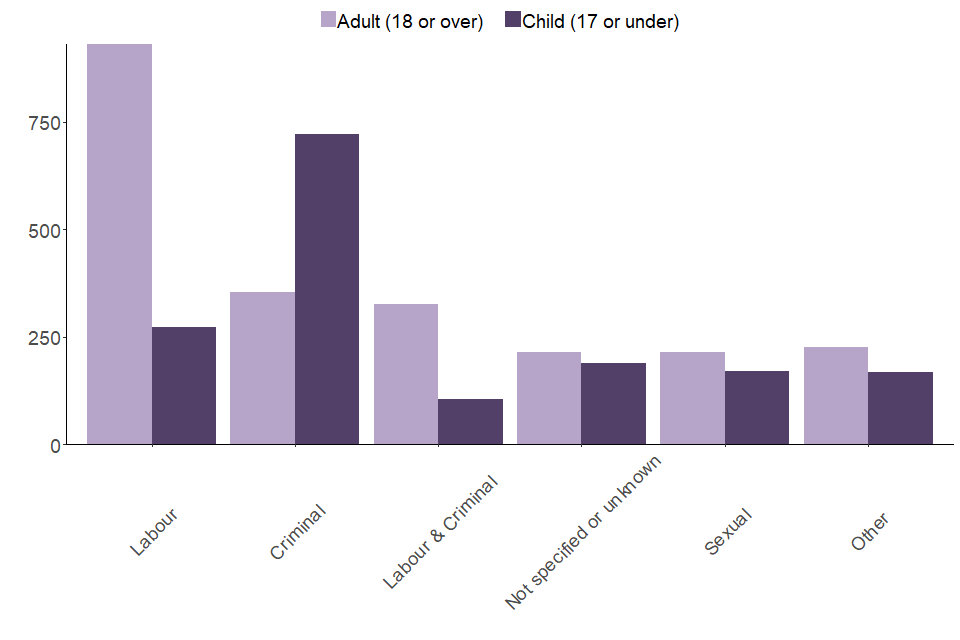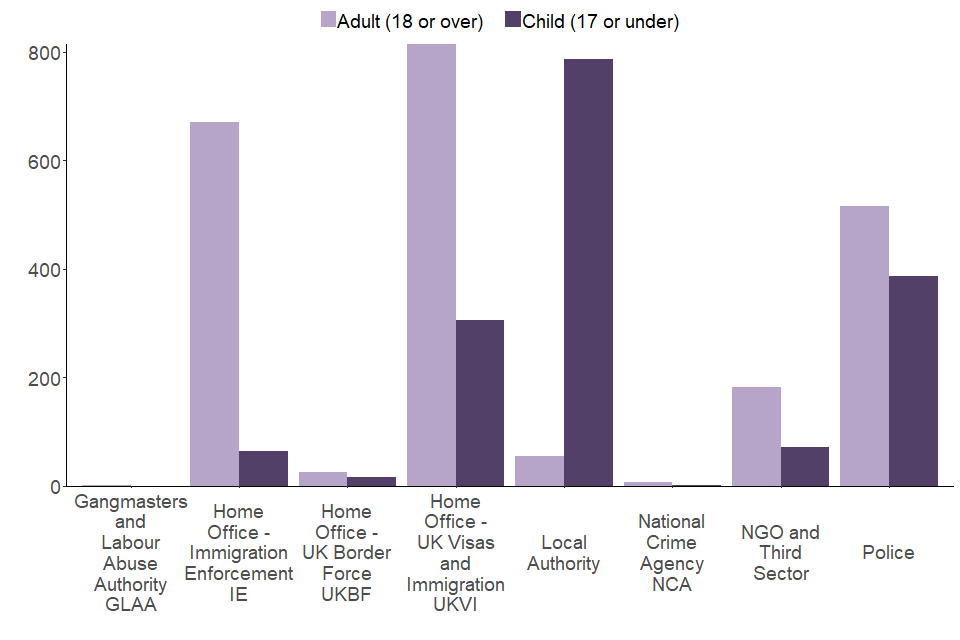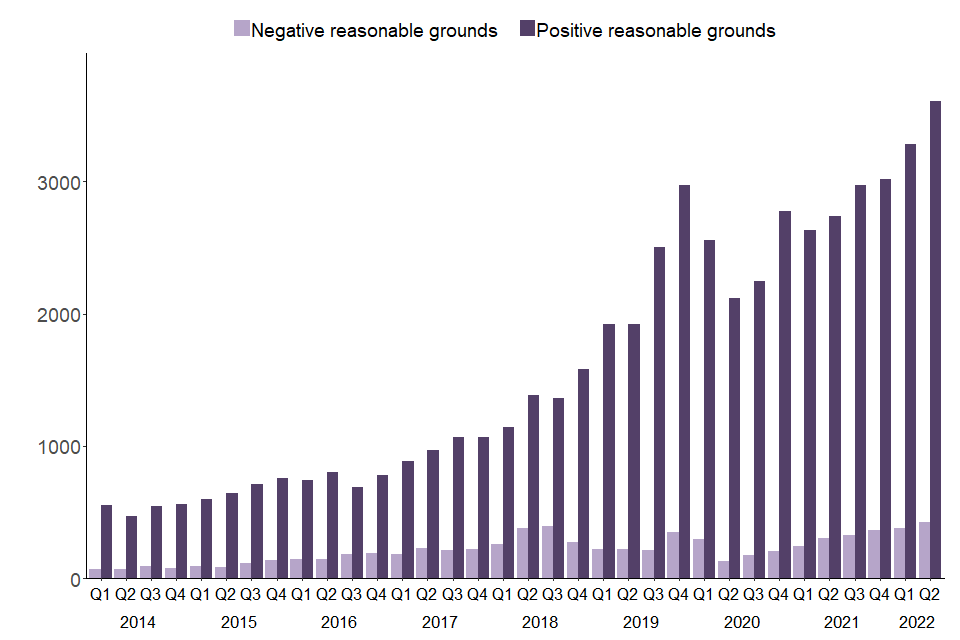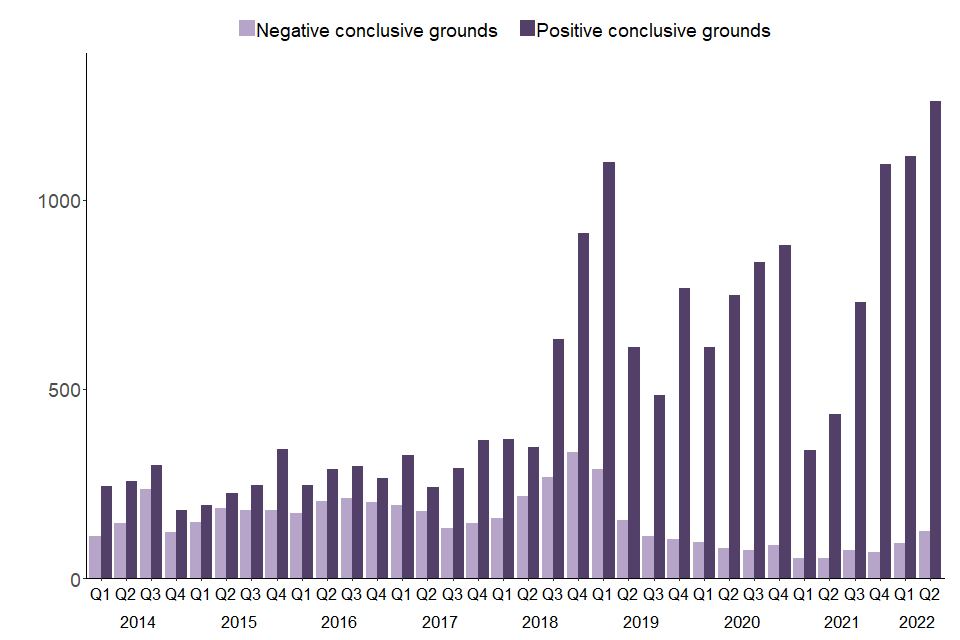Modern Slavery: National Referral Mechanism and Duty to Notify statistics UK, Quarter 2 2022 – April to June
Published 11 August 2022
This statistical bulletin provides a summary and breakdown of the number of potential victims of modern slavery referred into the National Referral Mechanism (NRM) or via the Duty to Notify (DtN) process from 1 April to 30 June 2022 (quarter 2). Please also refer to the data tables published alongside this bulletin for further data. To access raw data related to referrals from 2014 onwards, register with UK Data Service.
Frequency of release: Quarterly
Home Office Responsible Statistician: Amy Baxter, Chief Statistician
Key results
- 4,171 potential victims of modern slavery were referred to the Home Office in quarter 2 2022, representing a 10% increase compared to the preceding quarter (3,777) and a 34% increase from quarter 2 2021 (3,124)
- the number of referrals received has exceeded 4,000 for the first time in a quarter and is the highest since the NRM began in 2009
- 75% (3,134) were sent to the Single Competent Authority (SCA) for consideration and 25% (1,037) to the Immigration Enforcement Competent Authority (IECA)
- 79% (3,298) were male and 21% (866) were female
- 48% (2,003) of potential victims claimed exploitation in the UK only and 43% (1,794) claimed exploitation overseas only
- both the number and proportion of potential victims that claimed exploitation overseas only this quarter are at their highest since the NRM began
- 54% (2,268) of referrals were for potential victims who claimed exploitation as adults and 39% (1,630) claimed exploitation as children
- adult potential victims most commonly claimed labour exploitation (41%; 931), whereas child potential victims were most often referred for criminal exploitation (44%; 722)
- the most common nationalities referred this quarter were Albanian, UK and Eritrean
- the number of Albanian nationals referred this quarter was the highest since the NRM began
- 4,033 reasonable grounds and 1,386 conclusive grounds decisions were issued this quarter; of these, 89% of reasonable grounds and 91% of conclusive grounds decisions were positive
- the number of reasonable grounds decisions issued this quarter was the highest since the NRM began
- the Home Office received 1,125 reports of adult potential victims via the DtN process, the highest quarterly figure since the DtN began
Figure 1: Number of quarterly NRM referrals by competent authority

Source: SCA, IECA
Notes:
- Excludes data pre-2014 due to data reliability.
1. Introduction
Modern slavery is a term that includes any form of human trafficking, slavery, servitude or forced labour, as set out in the Modern Slavery Act 2015. Potential victims of modern slavery in the UK that come to the attention of authorised first responder organisations are referred to the NRM.
Authorised first responder organisations include local authorities, specified non-governmental organisations (NGOs), police forces and specified government agencies. Adults (aged 18 or above) must consent to being referred to the NRM, whilst children under the age of 18 need not consent to being referred. Adults who were exploited as children can also be referred. As specified in section 52 of the Modern Slavery Act 2015, public authorities in England and Wales have a statutory duty to notify the Home Office when they come across potential victims of modern slavery. This duty is discharged by either referring a child or consenting adult potential victim into the NRM, or by notifying the Home Office via the DtN process if an adult victim does not consent to enter the NRM.
When referred to the NRM, the Home Office makes a ‘reasonable grounds’ decision on whether an individual could be a victim of modern slavery. Adults given a positive reasonable grounds decision can have access to support if they need it (including accommodation, subsistence, legal aid and counselling) pending a ‘conclusive grounds’ decision on their case. Local authorities support children.
Currently, adults with a positive conclusive grounds decision are entitled to at least a further 45 days of support, whilst those with a negative decision receive nine days of ‘move on’ support as the individual exits the service. See further information regarding the NRM process.
Trained specialists in the Home Office decide who is recognised as a victim of modern slavery. The SCA was launched in April 2019 and the IECA was created 8 November 2021. Both competent authorities recognise victims of modern slavery for cases referred to the NRM across the UK. See further information regarding both competent authorities (PDF, 1416KB).
On 14 June 2021, the Home Office launched a pilot programme that will test alternative models of decision-making for child victims of modern slavery and human trafficking. Decisions made by the ten pilot areas, which are then issued by the SCA, are included in the data used for the bulletin. See further information regarding the pilots.
2. National Referral Mechanism (referrals)
2.1 Number of referrals by age group
In quarter 2 2022, the NRM received 4,171 referrals of potential victims of modern slavery, the highest quarterly figure since the NRM began. This represents a 10% increase in referrals compared to the preceding quarter (3,777) and a 34% increase from quarter 2 in 2021 (3,124).
Of all referrals this quarter, 54% (2,268) were for potential victims who claimed exploitation as adults (matching the proportion of the previous quarter), whilst 39% (1,630) claimed exploitation as children (Figure 2). This quarter saw both the highest number of potential victims claiming exploitation as adults and those claiming exploitation as children since the NRM began. The age group at exploitation was unknown in 7% of cases (273).
Figure 2: Number of quarterly NRM referrals by age group of exploitation

Source: SCA, IECA
Notes:
- Excludes data pre-2014 due to data reliability.
- Excludes referrals where the age group at exploitation is unknown.
2.2 Location of exploitation
Overall, 48% (2,003) of potential victims claimed exploitation in the UK only, compared to 54% in quarter 1 2022, and 43% (1,794) claimed exploitation overseas only, compared to 36% in quarter 1 2022 (data table 2; Figure 3). Following a substantial decrease in quarter 1 2021, referrals for those claiming exploitation overseas only have reached both their highest number and proportion.
Figure 3: Number of quarterly NRM referrals by location of exploitation

Source: SCA, IECA
Notes:
- Excludes data pre-2014 due to data reliability.
2.3 Referrals by gender and exploitation type
Overall, of the 4,171 potential victims referred in this quarter, 79% (3,298) were male and 21% (866) were female. Both the number and proportion of referrals for male potential victims this quarter are at their highest since the NRM began. The proportion of male potential victims has broadly followed a small increasing trend over the years.
For adult potential victims, 79% (1,782) were male and 21% (486) were female; whilst for child potential victims, 79% (1,291) were male and 20% (332) were female.
Figure 4: Number of NRM referrals, by exploitation type and age group

Source: SCA, IECA
Notes:
- First responders can enter data for unclassified exploitation in a free-text field; for statistical reporting, this field is grouped as ‘Not specified or unknown’.
Overall, potential victims were most commonly referred for labour exploitation only, which accounted for 32% (1,314) of all referrals. For adult potential victims, labour exploitation was most commonly reported (41%; 931), whereas child potential victims were most often referred for criminal exploitation (44%; 722). See further information on types of exploitation.
Throughout 2020, a rapid increase in the identification of ‘county lines’ cases partially drove the increase in referrals for children within the criminal exploitation category. In 2021, cases flagged as county lines remained at this high level, averaging over 500 referrals a quarter. County lines is a term used to describe drug gangs in large cities expanding their reach to small towns. Often, the gangs exploit vulnerable individuals to transport substances, and mobile phone ‘lines’ are used to communicate drug orders. See further information on county lines.
In quarter 2 2022, 589 county lines referrals were flagged, the highest quarterly number since this data was collected. County lines referrals accounted for 14% of all referrals received (data table 14), with most of these for male children (76%; 446).
Figure 5: Number of NRM referrals flagged as county lines, by age group at exploitation and gender

Source: SCA, IECA
Notes:
- County lines referrals were classified as a sub-type of labour exploitation prior to quarter 4 2019.
- Since January 2020, a ‘flag’ within the NRM digital casework system identifies county lines referrals.
2.4 Referrals by nationality
The most common nationality referred was Albanian, which accounted for 27% (1,130) of all potential victims (matching the proportion of the previous quarter). The number of Albanian nationals, which reached its highest figure since the NRM began, has surpassed UK nationals for the second consecutive quarter. The second most commonly referred nationality was UK (24%; 1,013) and the third was Eritrean (7%; 293). The number of Eritrean nationals has broadly risen over the years and has been the third most commonly referred nationality for the third quarter running. A large proportion (80%; 813) of UK nationals were child potential victims, whilst for Albanian nationals, most (81%; 910) were adult potential victims. For Eritrean nationals, 68% (198) were adults and 26% (76) were child potential victims (Figure 6).
Please note, a change to data recording from 1 October 2019 means that NRM data reflects the dual nationality of potential victims in separate categories. To see total counts of a particular nationality, please refer to the data tables. A potential victim’s nationality is based on information provided by the first responder upon referral; however case workers may update this as further information is gathered.
Figure 6: Number of NRM referrals for the most common nationalities of potential victims, by age group at exploitation

Source: SCA, IECA
Notes:
- Excludes potential victims with an unknown age at exploitation.
- There are separate categories for dual-nationals.
2.5 Referrals by location of crime investigation
Upon receiving an NRM referral, the SCA determines the responsible geographic police force for investigation, based on the information provided on the referral form, and transfers the referral. Transfer between police forces can take place as they receive further information, which is reflected in the statistics. Previously, British Transport Police referrals were classed under England, but are now separate in the data tables.
As in previous quarters, most (90%; 3,736) of the NRM referrals were sent to police forces in England, with 4% (152) to Police Scotland, 3% (139) to Welsh police forces and 3% (140) to the Police Service of Northern Ireland (data table 2).
2.6 First responders
In quarter 2 2022, 50% (2,104) of the referrals came from government agencies, compared to 45% in the previous quarter. Of these referrals, 40% (836) came from Home Office Immigration Enforcement, compared to 41% in quarter 1 2022, whilst a large proportion came from UK Visas and Immigration (58%; 1,212) (Figure 7 and data table 10). NGO and third-sector organisations accounted for 6% (265) of referrals (data table 11). Police forces accounted for 23% (950) of NRM referrals in quarter 2, compared to 25% in quarter 1 2022 (data table 12). Local authorities accounted for 20% (852) of referrals, mostly for child potential victims (data table 13).
Figure 7: Number of NRM referrals by first responder types

Source: SCA, IECA
Notes:
- Excludes potential victims with an unknown age at exploitation.
3. National Referral Mechanism (decisions)
3.1 Reasonable grounds decisions
In quarter 2 2022, 4,033 reasonable grounds decisions were issued, the highest quarterly number since the NRM began. Of these, the SCA issued 3,123 and the IECA 910; 88% (2,758) of decisions made by the SCA were positive compared to 94% (851) of decisions made by the IECA (data tables 16 and 17).
Of the 4,033 reasonable grounds decisions issued this quarter, the proportion of positive reasonable grounds decisions was 87% for adult and 93% for child potential victims (data table 15). The proportion of positive decisions has remained relatively similar in recent years, with around nine out of every ten referrals receiving a positive decision.
Figure 8: Number of NRM positive and negative reasonable grounds decisions

Source: SCA, IECA
Notes:
- Based on the quarter in which the competent authority issued their decision.
3.2 Conclusive grounds decisions
In quarter 2 2022, 1,386 conclusive grounds decisions were issued, compared to 1,208 in quarter 1 2022 and 489 in quarter 2 2021. The number of conclusive grounds decisions issued this quarter is the second highest since the NRM began, following the increasing trend since the early months of 2021 due to the recruitment of additional decision makers by the SCA. For decisions issued this quarter, the proportion of positive conclusive grounds decisions was 91% for adult and 92% for child potential victims (data table 18).
Of the 1,386 decisions issued this quarter, 1,278 were issued by the SCA and 108 by the IECA (data tables 19 and 20); 91% (1,158) of decisions issued by the SCA were positive compared to 96% (104) of decisions issued by the IECA.
Figure 9: Number of NRM positive and negative conclusive grounds decisions

Source: SCA, IECA
Notes:
- Based on the quarter in which the competent authority issued their decision.
The average (median) time taken from referral to conclusive grounds decisions made in quarter 2 2022 across the competent authorities was 536 days, compared to 448 days in quarter 1 2022 (data table 21). For conclusive grounds decisions made by the SCA, the average time taken this quarter was 580 days, whilst the IECA took an average of 160 days (data tables 22 and 23). Decision-making times for the IECA are currently much shorter than the SCA; this reflects the IECA having fewer cases assigned to decision makers in their backlog compared to the SCA, given the IECA have only taken on new referrals since November 2021.
It is important to note that the decision-making times presented here are for cases that received a conclusive grounds decision from the competent authority in this period and do not reflect the waiting time of all cases within the system. Some cases that receive decisions in this period may have taken longer to reach a decision than those in previous quarters.
3.3 Duty to Notify
Since 1 November 2015, specific public authorities (PDF, 1416KB) in England and Wales must notify the Home Office via the DtN process of suspected adult victims of modern slavery that do not consent to enter the NRM. During this process, first responders do not collect the potential victim’s personal details.
In quarter 2 2022, the Home Office received 1,125 reports of adult potential victims via the DtN process (data table 24; Figure 10), compared to 987 in quarter 1 2022. The number for quarter 2 2022 is the highest ever recorded. Of these:
-
the most referred nationalities were Eritrean (265; 24%), Albanian (204; 18%) and UK (87; 8%) (data table 25)
-
the most commonly referred exploitation types were labour (475; 42%), not recorded or unknown (209; 19%) and sexual (160; 14%) (data table 26)
-
in terms of first responders, most DtN reports were submitted by Home Office – UK Visas and Immigration UKVI (663; 59%), Metropolitan Police Service (68; 6%) and Home Office – UK Border Force UKBF (59; 5%) (data table 27)
Figure 10: Number of quarterly DtN referrals

Source: SCA
Notes:
- Potential victims may be reported via DtN and subsequently also referred to the NRM at a later point in time, so these figures should not be combined due to potential double counting.
4. Further information
Quality information
All percentages are rounded to the nearest whole percentage point.
It is important to note that the statistics presented in this publication relate to the number of potential victims of modern slavery referred to the NRM or via the DtN process.
These statistics are based on the situation as of 5 July 2022 when an extract was taken from the live management information system. The figures may differ from previous or future reports as new information comes to light and cases update accordingly.
NRM statistics were previously published by the National Crime Agency (NCA) prior to transfer of NRM decision-making responsibilities to the SCA in April 2019 as part of the NRM Reform Programme. Publications prior to July 2019 can be accessed via the NCA website. With this transfer of responsibility, these data are now designated as official statistics and produced in line with the Code of Practice for Statistics.
Data tables for further analysis are online alongside this bulletin.
This statistical bulletin has been produced to the highest professional standards and is free from political interference. It has been produced by statisticians working in the Home Office Analysis & Insight Directorate under the Home Office’s Statement of compliance with the Code of Practice for Official Statistics, which covers Home Office policy on revisions and other matters. The Chief Statistician, as Head of Profession, reports to the National Statistician regarding all professional statistical matters and oversees all Home Office National Statistics products regarding the Code, being responsible for their timing, content and methodology.
Changes to data table formatting
As of quarter 3 2021, several of the data tables published alongside this bulletin have been reformatted to reduce the number of tables whilst still providing the same data. Table 7 (Number of NRM referrals by UK country of responsible police force and age group) which was provided in previous updates has been removed as this information is available in table 2. Tables 16 to 26 provided in previous updates (breaking down referrals received by police forces from England, Northern Ireland, Wales and Scotland by nationality, exploitation type, first responder and age at exploitation) have been removed. This information is now available in tables 3 to 8. The information previously provided in tables 11 to 13 breaking down referrals for each first responder is now provided in tables 10 to 12.
As of quarter 1 2022, this bulletin has included both the number of referrals and decisions split by the SCA and IECA. To reflect this, tables 15 and 16 (number of positive and negative NRM reasonable/conclusive grounds decisions made per quarter, by age group at exploitation) in previous releases have been split into an additional two tables each for SCA and IECA decisions. Reasonable grounds decision breakdowns are therefore provided as tables 15 to 17, whilst conclusive grounds breakdowns are provided as tables 18 to 20.
As of this quarter, the average time between referrals and conclusive grounds decisions has been split by the SCA and IECA. Due to this, table 21 (average number of days taken to make conclusive grounds decisions) in past releases is now split into an additional two tables for SCA and IECA times. Timeliness breakdowns are therefore provided as tables 21 to 23. Tables 22 to 25 in previous releases are now provided as tables 24 to 27.
Changes to recording of exploitation types
Prior to 1 October 2019, potential victims of modern slavery were recorded as having a single primary exploitation type, grouped into five distinct categories: labour, sexual, domestic servitude, organ harvesting or unknown exploitation. Following changes to the way NRM data are collected, recording of exploitation types has changed to give a better picture of the exploitation experienced by potential victims. As a result, for referrals received from 1 October 2019, criminal exploitation is separate to labour exploitation. In addition, potential victims can also be recorded as experiencing multiple exploitation types, so apply caution when comparing exploitation type statistics from quarter 4 2019 with previous quarters, as the primary exploitation type is unknown. Furthermore, ‘Unknown exploitation’ is no longer a distinct category on the online form that first responders use when submitting a referral; instead, they can provide information for unclassified exploitation in a free-text box field. For statistical reporting, this field is grouped as ‘Not specified or unknown’.
Criteria applied to identify the relevant police force:
Police force data provided in associated reference tables are based on the location of the police force that received the NRM referral. Each referral is screened against the criteria below to identify the responsible geographic police force. Once identified, the referral is transferred for action to the relevant Force Intelligence Bureau or stipulated point of receipt within the force. Sometimes, further information is received and processed regarding a referral, which means it will be sent to a different police force. This will be reflected in the updated statistics. Criteria applied to identify the relevant police force are:
- the force has acted as first responder, or the referral indicates that the force is already involved in the recording/investigation of the potential modern slavery human trafficking offences
- the potential victim has been exploited within the force area
- the potential victim has been exploited abroad, or at an unknown location and the victim’s address at time of referral is within the force area
- the potential victim has been exploited abroad or at an unknown location and they have presented to another first responder within the force area
Other related publications
National Referral Mechanism statistics
Feedback and enquiries
We are always looking to improve the accessibility of our documents. If you find any problems, or have any feedback, relating to accessibility, or general questions regarding this publication, please email us NRMStatistics@homeoffice.gov.uk
For press enquires: pressoffice@homeoffice.gov.uk; 02070353535
